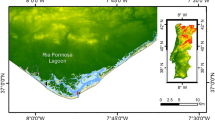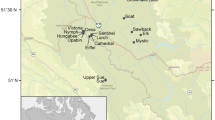Abstract
Comparative laboratory bioassays using Asterionella formosa and Rhodomonas lacustris as test organisms were performed from March to November 1987 on filtered water samples from two English lakes, to assess their potential fertility and to identify possible limiting nutrients. The relative growth responses (log2 increments) per week, were measured after additions of P, Fe, Si, N, and K singly and in combinations in comparison with unenriched (control) samples. Phosphate appeared to be the major limiting element for both species throughout the year, except during the spring diatom maxima when silicon usually becomes limiting. On most occasions chelated iron increased the growth increments, particularly in combination with phosphate. In general, the bioassay results showed correspondence with the nutrient concentrations in the test waters, which showed low (< 1 µg l−1) levels of soluble reactive phosphate during all or most of the year and depleted silicon levels in late spring. Comparison between relative (incremental) ratio and absolute (cell concentration) response was made.
Similar content being viewed by others
References
Beakes, G., H. M. Canter & G. H. M. Jaworski, 1988. Zoospore ultrastructure of Zygorhizidium affluens Canter and Z. planktonicum Canter, two chytrids parasitizing the diatom Asterionella formosa Hassal. Can. J. Bot., 66: 1054–1067.
Box, J. D., 1983. Temporal variation in algal bioassays of water from two productive lakes. Arch. Hydrobiol. Suppl. 67, 1: 81–103.
Clasen, J. & H. Bernhardt, 1974. The use of algal assays for determining the effect of iron and phosphorus compounds on the growth of various algae species. Wat. Res. 8: 31–44.
Davison, W. & E. Rigg, 1976. Performance characteristics for the spectro-photometric determination of total iron in fresh water using hydrochloric acid. Analyst 101: 634–638.
Fitzgerald, G. P., 1972. Bioassay analysis of nutrient availability. In: H. E. Allen & J. R. Kramer (eds.). Nutrients in Natural Waters, Wiley-Interscience Publ., N.Y. John Wiley & Sons, Inc. 147–169.
Lund, J. W. G., 1950. Studies on Asterionella formosa Hass. II. Nutrient depletion and the spring maximum. J. Ecol. 38: 1–35.
Lund, J. W. G., 1959. A simple counting chamber for nannoplankton. Limnol. Oceanogr. 4: 57–65.
Lund, J. W. G., 1961. The algae of the Malham Tarn District. Field Studies 1 (3): 85–119.
Lund, J. W. G., 1962. A rarely recorded but very common British alga, Rhodomonas minuta Skuja. Br. Phycol. Bull., 2 (3): 133–139.
Lund, J. W. G., F. J. H. Mackereth & G. H. Mortimer, 1963. Changes in depth and time of certain chemical and physical conditions and of the standing crop of Asterionella formosa Hass. in the north basin of Windermere in 1947. Phil. Trans. Roy. Soc. Lond. (B) 246: 255–290.
Lund, J. W. G., G. H. M. Jaworski & H. Bucka, 1971. A technique for bioassay of freshwater, with special reference to algal ecology. Acta Hydrobiol. 13: 235–249.
Lund, J. W. G., C. Kipling & E. D. Le Cren, 1958. The inverted microscope method of estimating algal numbers and the statistical basis of estimations by counting. Hydrobiologia 11: 143–170.
Lund, J. W. G., G. H. M. Jaworski & C. Butterwick, 1975. Algal bioassay of water from Blelham Tarn, English Lake District and the growth of planktonic diatoms. Arch. Hydrobiol./Suppl. 49: 49–69.
Mackereth, F. J. H., 1953. Phosphorus utilization by Asterionella formosa Hass. J. Exp. Bot. 4: 296–313.
Mackereth, F. J. H., J. Heron & J. F. Talling, 1978. Water analyses: some revised methods for limnologists. Sci. Publ. Freshwat. Biol. Ass. 36: 124 pp.
Marvan, P., 1979. Algal assays — an introduction into the problem. In: P. Marvan, S. Pribil, O. Lhotsky (eds), Algal assays and monitoring Eutrophication, pp. 17–22, Třebôn, Czechoslovakia, E. Schweizerbart'sche Verlagsbuchlandlund, Stuttgart.
Reynolds, C. S., 1984a. The ecology of freshwater phytoplankton. Cambridge University Press, Cambridge. 384 pp.
Reynolds, C. S., 1984b. Phytoplankton periodicity: the interactions of form, function and environmental variability. Freshwat. Biol. 14: 111–142.
Reynolds, C. S., 1986. Diatoms and the geochemical cycling of silicon. In: B. S. C. Leadbeater, J. R. Riding (eds.), Biomineralization in lower plants and animals, pp. 269–289. Oxford University Press, Oxford.
Reynolds, C. S. & C. Butterwick, 1979. Algal bioassay of unfertilized and artificially fertilized lake water, maintained in Lund tubes. Arch. Hydrobiol. Suppl. 56: 166–183. maintained in Lund tubes. Arch. Hydrobiol. Suppl. 56: 166–183.
Storch, T. A. & V. L. Durham, 1986. Iron-mediated changes in the growth of Lake Erie phytoplankton and axenical algal cultures. J. Phycol. 22: 109–117.
Sutcliffe, D. W., T. R. Carrick, J. Heron, E. Rigg, J. F. Talling, C. Woof & J. W. G. Lund, 1982. Long-term and seasonal changes in the chemical composition of precipitation and surface waters of lakes and tarns in the English Lake District. Freshwat. Biol. 12: 451–506.
Talling, J. F., 1976. The depletion of carbon dioxide from lake water by phytoplankton. J. Ecol. 64: 79–121.
Talling, J. F., 1985. Inorganic carbon reserves of natural waters and ecophysiological consequences of their photosynthetic depletion: micro algae. In: W. J. Lucas, J. Lucas & J. Berry (eds.), Bicarbonate utilization and transport in plants. Amer. Soc. Plant. Physiol.: 403–420.
Talling, J. F. & S. I. Heaney, 1988. Long-term changes in some English (Cumbrian) lakes subjected to increased nutrient imputs. In: F. E. Round (ed.), Contributions to algal biology and environments in honour of J. W. G. Lund. Biopress, Bristol (in press).
Taylor, W. D. & R. G. Wetzel, 1984. Population dynamics of Rhodomonas minuta var. nannoplanctica Skuja (Cryptophyceae) in a hardwater lake. Verh. Int. Ver. Limnol. 22: 536–541.
Weiss, C. M., 1976. Evaluation of the algal assay procedure. U.S. Envir. Protect. Agency Corvallis, Oregon, 58 pp.
Wurtsbaugh, W. A. & A. J. Home, 1983. Iron in eutrophic Clear Lake, California: its importance for algal nitrogen fixation and growth. Can. J. Fish. Aquat. Sci. 40: 1419–1429.
Author information
Authors and Affiliations
Rights and permissions
About this article
Cite this article
Barbosa, F.A.R. Evidence from algal bioassays of seasonal nutrient limitations in two English lakes. Hydrobiologia 188, 211–228 (1989). https://doi.org/10.1007/BF00027787
Issue Date:
DOI: https://doi.org/10.1007/BF00027787




